Installing the corrugation on the toilet and the specifics of connecting plumbing with it
Lightweight ‚but durable plastic sanitary fittings greatly simplified the installation of many devices. In particular ‚corrugation for the toilet allows you to connect the release of this type of plumbing to the sewer drain much faster and without much difficulty.
Do you want to install a corrugation with your own hands? We will tell you how to do this - the article describes the installation procedure for corrugations and options for connecting toilets with a different type of release. Installation tips and tricks for choosing the best corrugation are also provided.
Thanks to a detailed analysis of important nuances, the connection procedure is quite accessible even to an amateur.
The content of the article:
Types of corrugations and selection tips
Corrugation belongs to the class of spillway fittings. This is a durable stretch adapter made of polymeric materials and shaped like an accordion. Its properties remain unchanged even when it is heated and stretched.
The corrugated pipe has the shape of a sleeve with a plastic sleeve having a rubber seal inside. With its help, toilet bowls with different types of flushing are connected to the sewer - oblique and horizontal.
Its dimensions are in the range of 21.2 - 50 cm. The end of the pipe with an outlet ‚has a cross section of 11 cm, and connected to the outlet - 7.5 cm inside and 13.4 on the outer surface.
Varieties of Corrugated Pipe
The corrugations are unreinforced or soft, reinforced with walls ‚reinforced with stainless wire‚ hard. The first are relatively cheap and have not very high strength characteristics.
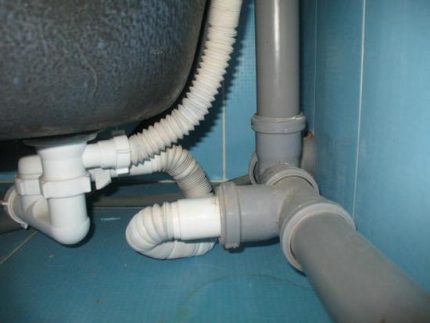
Soft corrugation fits any design and is easier to install. It is bad that after several years of operation it may be difficult to drain due to sagging of the corrugated adapter.
The reinforced pipe has much higher characteristics ‚it is more reliable and durable‚ but also more expensive. These corrugated pipes have a rigid pipe with a turn ‚and the corrugation is a continuation of it. They are indispensable when you need to connect a toilet with an oblique outlet to the drain.
Detailed information on the types of toilets and types of release is discussed in another our article.
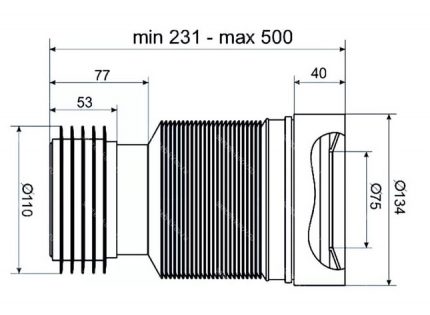
The corrugation is also divided by such a criterion as length - they are short and long. The length of the folded short corrugation is 21.2 cm, and if it is stretched - 32 cm. The compressed long corrugation has a length of 28.5 cm, and it can be stretched to 0.5 m.
Do not tighten the connector end-to-end - this can lead to leaks. When choosing a corrugation, you need to look at the density of the material, the state of the gaskets, the uniformity of the cuff.
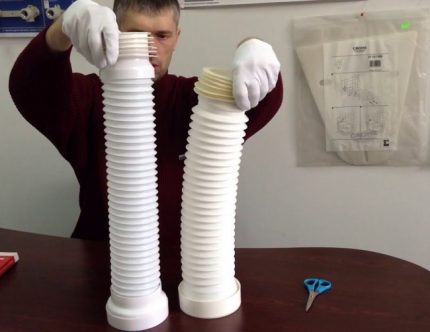
Corrugations differ in the direction of the bell. It can be straight and curved both under 45⁰, and under 90⁰.
When is corrugation used?
The use of corrugation is justified in 3 cases:
- When the bowl and the bell have different types of release. This is common ‚because The design characteristics of the toilets are different. Not all types of these plumbing fixtures can be connected in a standard way ‚and then the corrugated pipe can act as an adapter.
- The toilet is displaced with respect to the sewer pipe. This situation is possible when tiles are laid on the floor or when the location of the toilet is changed. No other pipes can connect mismatched elements, and only the use of corrugations can easily solve the problem.
- As a temporary option for connecting the toilet.
The use of corrugation provides many advantages, but this method is not without drawbacks. The plastic walls are thin and if something sharp comes into the pipe accidentally, they will be damaged. It is dangerous for corrugation and boiling water. All this reduces the juice service plastic connector. If the corrugation is stretched and not fixed, it will sag.
Features of the choice of corrugation
When buying a corrugation for connecting a toilet ‚you need to choose the highest quality. This will reduce to zero the possibility of leaks and will last such a product longer. The price difference is small, so it’s better to pay a little extra and save yourself from unnecessary problems in the form of the contents of the pipe on the floor.
Any comparisons of domestic and foreign corrugations are not in favor of the first. Our corrugation poorly covers the walls of the pipe. No tricks help - the domestic corrugation does not completely adhere to the inner surface of the sewer pipe.
Often a corrugated pipe forms waves, due to which a leak appears. Even a professional installation will not help to avoid such troubles.
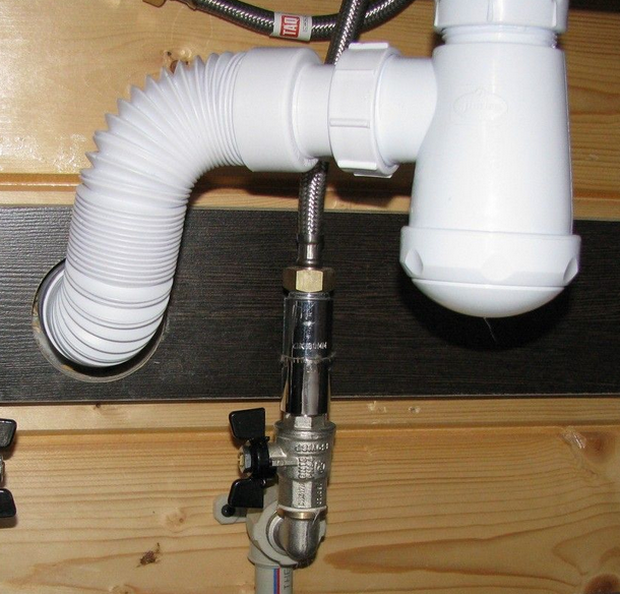
The best countries producing corrugations are Italy, Czech Republic, England. Visiting the market, you will notice that most of the products are sourced from China. Do not be tempted by their cheapness ‚they will not last long and what seems to be a saving‚ will result in additional costs.
When choosing a corrugated sleeve, you should look at the thickness of its walls. If the other characteristics are equivalent, then you should buy the one with thicker walls. It is bad that this information is not always indicated in the description attached to the product.
Some corrugated pipes are designed for attaching gum together with a plastic ring. There are models in which a direct connection is provided - the gum is inserted into the end and fixed to the "Christmas tree". The second option is more reliable.
The procedure for connecting the toilet with the corrugation
The work of connecting the toilet is not difficult, but a certain sequence of actions must be followed. It is more convenient to start installing the corrugation to the toilet both to the new and the old, even before it is fixed in a constant place.
When you don’t need to do anything with the product that you just brought from the store ‚the release of the old appliance must be freed from layers of cement or sealant.
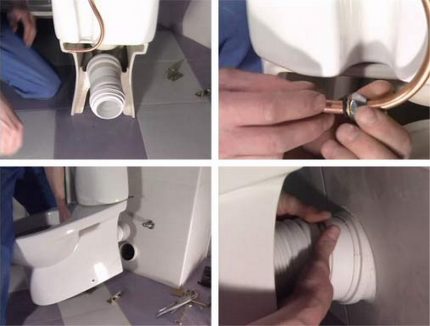
You need to clean and the socket of the sewer pipe. If you do not free this place from the remains of materials, it will be difficult to ensure the tightness of the connection.
Then they operate according to the following scheme:
- They process the end of the pipe with silicone, which they are going to connect to the sewer. The end of the outlet should be evenly overlapped by a branch of 50-60 mm. It is necessary to tighten with a turn ‚avoiding any distortions. To facilitate the process of tensioning the corrugations, soap the rubber seal in the bell with soap.
- A corrugated pipe is inserted into the inlet of the system at one end, and the other end is connected to the toilet.
- Water is poured into the toilet bowl to check the joints.
- Mark on the floor the attachment points of the toilet ‚having disconnected the corrugation before this.
- Drill holes and coat with sealant.
- Fasten the toilet to the floor. At the same time, the fixing bolts attract until the device ceases to stagger and becomes perpendicular to the floor. With increased effort, you can split the base.
- Reconnect the adapter ‚process the joints with a plumbing sealant and once again check them for leaks.
- The screed is poured and the floor surface is finished.
The release form of the floor toilet may be vertical ‚horizontal‚ oblique. In each case, the connection of the toilet has its own characteristics. In old houses, vertical and oblique outlets are most often found, and in new ones - horizontal.
To connect the toilet to the sewer pipe, the outlet of which is located in the floor, a corrugation with a bell curved at 90 ° is suitable. For a plumbing fixture with horizontal outlet, corrugation is generally used with a 45 ° rotation of the bell.
It happens that in a bathroom with a small area it is necessary to place a lot of plumbing fixtures. For this, it is necessary that there are many outlets on the sewer pipe, and this is not always realistic.
The only way out is to use a corrugation for the toilet with a tap. It is the only alternative when the bathroom is located almost right next to the toilet.
It happens that for some reason, the corrugation becomes unusable. Replacing it is easy. To do this, you don’t even have to dismantle the toilet, but you need to prepare rags and buckets.
Block the flow of water into the toilet drain, then disconnect the tube designed for the flow of water. The tank is freed from water and removed. The corrugated pipe is simply compressed and disconnected from the device. Next, take it out of the bell.

A new pipe is inserted into the socket, squeezed, pulled to the toilet outlet. All this can be done with a stretched corrugation. If it is extremely compressed, nothing will work. This is a nuance that must be taken into account during the initial installation.
We have other useful articles on the site with detailed instructions for installing toilets of various types and designs:
- How to install a toilet with an oblique outlet: detailed technical instructions
- Vertical release toilet: how it works and how, pros and cons, step-by-step installation instructions
- Corner toilet with a tank: pros and cons, scheme and features of installing a toilet in the corner
- How to connect a toilet to the sewer: an overview of installation technologies for all types of toilets
Some helpful installation tips
With all its advantages, the plastic corrugation is not designed for heavy loads, so it can not be mounted inside the wall. With a large distance from the wall to the plumbing fixture, carefully select the length of the connector.
The corrugation is stretched, but if this property is abused, the walls can become thinner and the structural strength decreases. It is not necessary to stretch the corrugation before its installation - this will lead to a sag in the tap.
Stretch it immediately before connecting to the sewer pipe. To avoid blockages, you do not need to allow a sag or counterclone of the corrugation. When the sewer pipe and the outlet of the plumbing fixture are located relatively high, a support is built under the connector.
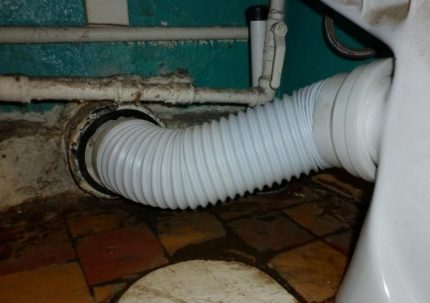
When you decide to install a protective screen to mask communications, and use the enclosed space as a place to store various little things, do not forget that a corrugation can be damaged with a heavy object.
Before you mount a plastic corrugation on the toilet, take into account the fact that a standard-sized product does not allow it to be installed right next to the wall. It’s better to apply eccentric.
We must not forget about plumbing standards when choosing a bias. Do not rotate the reinforced pipe at right angles. If the device occupies a non-standard position, a connecting element with an offset is used.
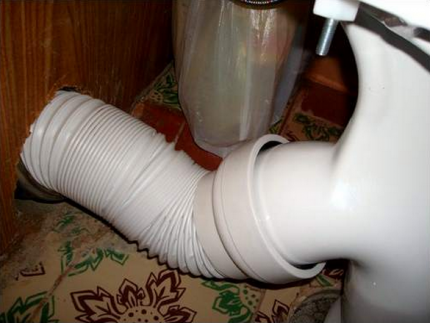
The corrugation can compensate for a fairly significant offset. Thanks to it, the device can be shifted by a maximum of 200 mm. And also it can be turned on any angle. To do this, apply such an option, as a series connection of two corrugated pipes.
Special attention must be paid to the angle at which the corrugation is curved. With a large pinch, draining cannot be carried out effectively. In addition to everything at the pinch point, the corrugation can crack.
Connection without corrugation
If the forms of release of the toilet bowl and the sewer pipe coincide, you can do without corrugation. When connecting a toilet bowl without corrugation, follow certain rules. In this case, an adapter is used which is also called a fan pipe or pipe.
The installation method is selected depending on the shape of the toilet outlet: in the case of oblique discharge, they are installed in the floor ‚with a vertical outlet, the toilet is mounted on the wall at an angle of 90 °, with a horizontal one - also in the wall, but at an angle of 30 to 40 °.
Option # 1 - vertical toilet discharge
A model of such a toilet is equipped with a siphon having an outlet pipe.Under this design, first mark the place, then install a flange with a latch.
A sewer pipe is mounted in its center and a plumbing fixture is installed. The toilet is rotated until it is completely fixed. The pipe takes its place automatically.
Such a scheme is good in that the wiring becomes invisible because pipes are hidden in the floor. It saves space. The downside is that to eliminate the leakage, you have to crack the floor covering.
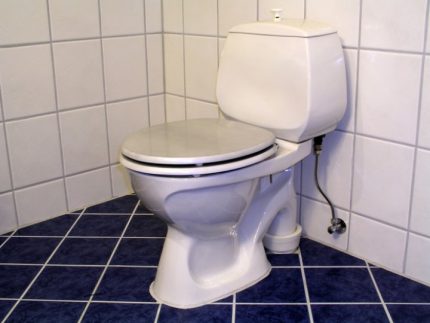
Option # 2 - horizontal release type
This release is directed back into the wall. Here you can not do without a sealing cuff. First, the dowels of the toilet are fixed to the floor. More on the best methods for fixing the toilet to the floor look here.
Then very carefully carry out the connection.
Initially, the seal cuff is installed without sealant, then it is tested by pressing the drain. If it does not leak anywhere, make the final installation.
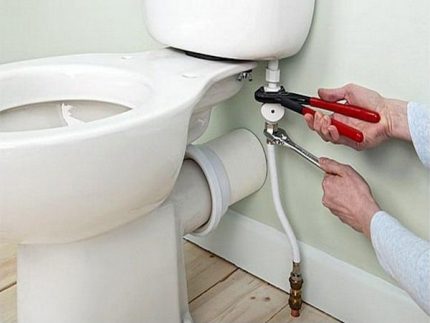
Option # 3 - oblique toilet release
To connect using a plastic pipe, the minium is mixed with drying oil and the toilet outlet is smeared with this. Top make a seal in the form of a resin strand. The seal is coated with meerk. The outlet is inserted into the sewer pipe and the toilet is mounted.
Here you can also apply a sealing cuff. Having put it on issue ‚the last is placed in a sewerage bell. Be sure to seal the connection.
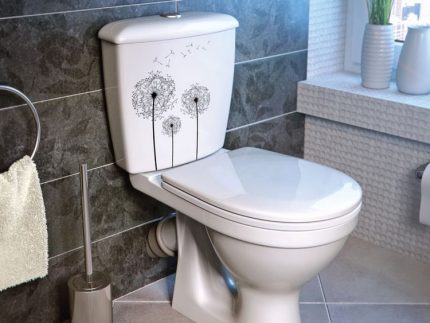
Conclusions and useful video on the topic
Here you will see how to install a toilet with a tap and connect it using a corrugation:
Here, the author talks about his own experience in connecting a toilet:
As you can see, the corrugation used to connect the toilet bowl is a small but very important element of the system. You must choose it responsibly, and when installing, you must follow all points of the instructions.
Subject to these recommendations, the design will be as durable as possible and will last a long time.
Do you know how to connect the toilet to the sewer using corrugation? Perhaps you noticed an inaccuracy in the description of the installation process discussed in our article? Or do you have useful recommendations based on your own experience? Write from this in the comments below.

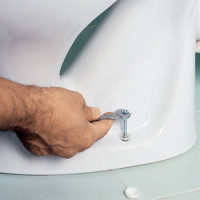 How to remove an old toilet: an overview of the technology for dismantling old plumbing
How to remove an old toilet: an overview of the technology for dismantling old plumbing 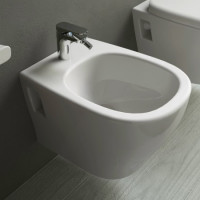 DIY bidet installation: specifics of installation and connection to communications
DIY bidet installation: specifics of installation and connection to communications 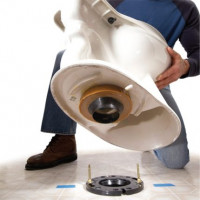 Vertical release toilet: device, pros and cons, installation features
Vertical release toilet: device, pros and cons, installation features 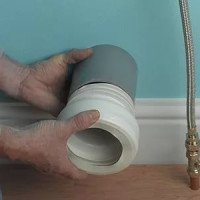 Rubber cuff for a toilet bowl (cam): rules of installation and connection
Rubber cuff for a toilet bowl (cam): rules of installation and connection 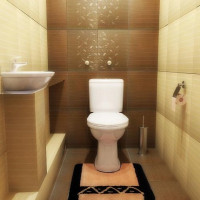 How to install a toilet with an oblique outlet: detailed technical instructions
How to install a toilet with an oblique outlet: detailed technical instructions 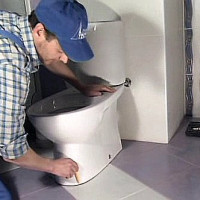 How to install a toilet on a tile with your own hands: step-by-step instruction + installation features
How to install a toilet on a tile with your own hands: step-by-step instruction + installation features  How much does it cost to connect gas to a private house: the price of organizing gas supply
How much does it cost to connect gas to a private house: the price of organizing gas supply  The best washing machines with dryer: model rating and customer tips
The best washing machines with dryer: model rating and customer tips  What is the color temperature of light and the nuances of choosing the temperature of the lamps to suit your needs
What is the color temperature of light and the nuances of choosing the temperature of the lamps to suit your needs  Replacement of a geyser in an apartment: replacement paperwork + basic norms and requirements
Replacement of a geyser in an apartment: replacement paperwork + basic norms and requirements
In principle, connecting the corrugation to the toilet is a simple matter. But still you need to be aware of all the nuances of installation. You need to know a few important details if you are not a professional plumber. Firstly, you must always select the correct length of the corrugation itself, which you need, no shorter and no longer. Secondly, that there would be no leaks, never screw the connector back to back. And of course, the corrugation itself should be made of quality material.
Well, yes, I immediately remember how I installed the toilet. Only my situation is different.Now, mostly manufacturers make toilet bowls with direct flush, and the sewer pipe is still my old cast iron, 250th. And it is located at an angle. Used as an adapter corrugation. I don’t remember the brand and manufacturer. The only thing I know is that I did not have to stretch it much. Now I think if the wall thickness of the corrugation is small, but I didn’t stretch it too much, will it work for me as an expensive analogue?
Hello. Well, here you can only guess. I have the cheapest corrugation that has just been found in the city, plowed tirelessly for 7 years, replaced the toilet faster 🙂 The corrugation is afraid of sagging, they accumulate clogs that are difficult to remove with a plumbing cable, you can damage the adapter. But you don’t have to, you have a small stretch. In general, the toilet should be operated correctly and there will be no problems with accessories and especially blockages.
How to extend the life of your corrugation:
1. Do not flush glass and other sharp objects into the toilet.
2. Carefully remove blockages with a plumbing cable.
3. Less commonly used are aggressive toilet cleaners that can thin the walls of the plastic.
4. Try not to flush a large amount of boiling water into the toilet.
5. Do not flush toilet paper or tissue (especially wet).
6. When pouring greasy water into the toilet (many use it as a drain), try diluting it with detergents beforehand.
7. If there is still a stretch, install supports under it.
It should be, it would seem, to install an ordinary corrugation, and so many nuances. To be honest, I stuck a corrugation with an eccentric in the drain at the time and somehow didn’t even think about the correct rotation and angle of inclination. Washes off and rinses itself for about 5 years.
Thank! A lot of useful information! But, can you tell me - the toilet is installed in the new building, but there is a strong unpleasant odor from the toilet. At the end of the corrugation, there should be some kind of opener-close when draining, so that smells do not come from the sewer pipe, right? Thank.